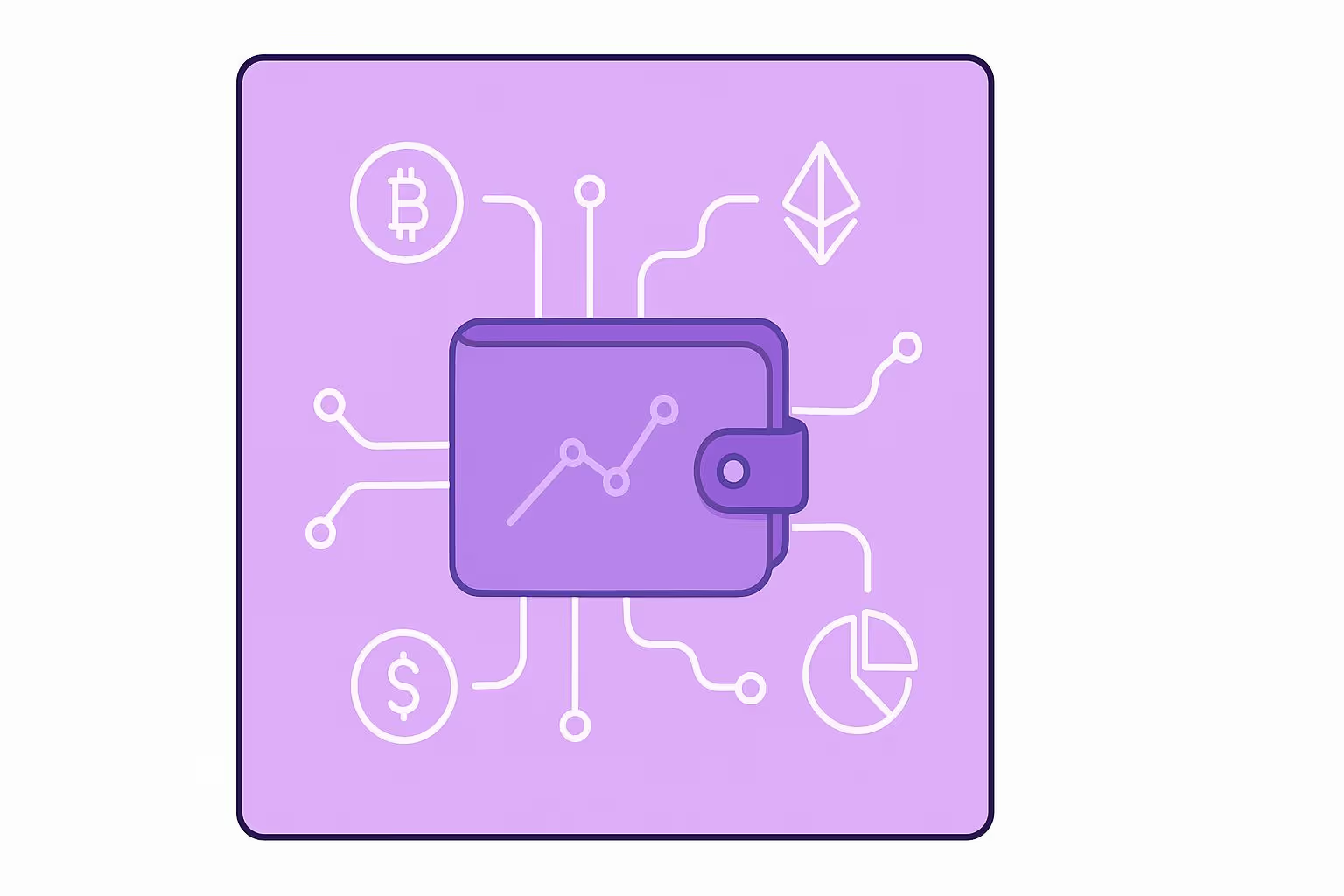12 Best Crypto Wallet Tracker Tools for 2025
Discover the 12 best crypto wallet tracker tools of 2025. Compare features, pricing and use cases to pick your ideal tracker today.

December 18, 2025
Wallet Finder

November 14, 2025

Want smarter crypto trading? Correlation analysis helps you see how cryptocurrencies move together, so you can manage risk, diversify, and make better decisions.
Bottom line: Correlation analysis helps you trade smarter, balance your portfolio, and stay ahead in the fast-moving DeFi world.
Keeping an eye on the right metrics can uncover patterns in asset behavior and open the door to early trading opportunities. These metrics are essential for understanding how market dynamics shift over time.
One of the most important metrics in DeFi correlation analysis is Total Value Locked (TVL). Think of it as the DeFi equivalent of traditional Assets Under Management (AUM). For instance, when TVL across protocols hit $75 billion on October 31, 2022, it reflected the capital flows that influence correlations between various DeFi assets.
Another key metric is trading volume. For example, Bitcoin’s trading volume has surpassed $130 billion within a single 24-hour period. Such spikes in volume can significantly impact correlation patterns across the crypto space. In October 2022, Uniswap alone processed $32.5 billion of the $50.8 billion total DeFi trading volume, showing how concentrated activity in certain platforms can shape cross-asset relationships.
Price volatility and liquidity also play a major role in shaping correlations. Illiquid markets are often more volatile, which tends to amplify correlations during periods of market stress. A good example is the sharp drop in TVL across all DeFi protocols, which fell from $183 billion in November 2021 to under $40 billion by late 2022. This liquidity crunch caused assets to move more closely together, especially during the downturn.
Metrics like protocol revenue provide additional insights. For instance, the top ten DeFi applications by market capitalization generated $92 million in revenue in October 2022. These revenue trends often align with token performance, offering hints about when assets might move in sync or diverge.
Lastly, Annual Percentage Yield (APY) differences across protocols can create unique correlation opportunities. Shifting yields often lead to capital flowing between protocols, potentially forming patterns that traders can anticipate and capitalize on.
Beyond raw numbers, market trend indicators help paint a clearer picture of how correlations evolve over time.
Using tools like moving averages alongside volume analysis can reveal the strength of correlations. For instance, when an EMA crosses above an SMA, it may signal a bullish trend that extends to related assets.
The Relative Strength Index (RSI) is another helpful tool. It can identify moments when correlations might break down. For example, during overbought or oversold conditions, assets that typically move together may start behaving differently due to unique market pressures.
Bollinger Bands are useful for spotting shifts in correlation dynamics. If one asset breaks above its upper band while its usually correlated counterpart stays within range, it could signal a change in their relationship.
Finally, on-chain activity metrics - like wallet behavior and transaction frequency - can hint at emerging shifts in correlation before they’re reflected in price data.
The real trick is combining multiple metrics rather than relying on just one. By layering these tools, traders can cut through market noise and find the signals that truly matter for making informed DeFi trading decisions.

Wallet Finder.ai is reshaping how traders analyze blockchain wallets by combining real-time data with powerful analytics. This platform merges live blockchain updates with user-friendly tools, making it easier to spot correlations and patterns across high-performing wallets and their trading strategies.
One standout feature is its ability to track complete wallet histories. With an average return of 340%, Wallet Finder.ai provides insights into wallets generating profits from over $1 million to more than $100 million. This detailed data helps traders understand how certain wallets behave during market shifts and which ones tend to move together.
Wallet Finder.ai specializes in identifying profitable blockchain wallets and trades across Ethereum, Solana, and Base. Here’s how its features simplify correlation analysis:
Wallet Finder.ai helps traders save time by delivering fast, actionable insights that improve decision-making. Its transparent analytics and automated token-security checks reduce risk exposure, allowing for more confident trades. By consistently highlighting top-performing wallets and emerging token trends, the platform provides an edge in understanding market dynamics and shifting correlations.
"I've tried the beta version of Walletfinder.ai extensively and I was blown away by how you can filter through the data, and the profitable wallets available in the filter presets, valuable for any trader or copy trader. This is unfair advantage."
– Pablo Massa, Experienced DeFi Trader
Ultimately, Wallet Finder.ai enables traders to focus on analyzing correlations and crafting effective strategies using both real-time and historical crypto performance data.
To make the most of your correlation analysis, it's important to follow a clear process and apply some proven techniques. Here's how you can approach it.
Start by gathering historical data from a variety of active wallets. This includes transaction records, token holdings, and timestamps. The more comprehensive your dataset, the better your analysis will be.
Choose the right correlation metrics. For example, you might look at how price movements correlate, using both historical and real-time data. This helps you identify long-term patterns as well as new, emerging trends. For traders seeking to capitalize on price differences across platforms, Wallet Analytics for Arbitrage Opportunities shows how analyzing wallet activity can reveal profitable trades and optimize execution strategies.
Next, calculate correlation coefficients. These range from -1 to +1, where -1 shows an inverse relationship, +1 shows perfect synchronization, and 0 means no relationship at all. Keep in mind that during major market events, correlations often rise. For instance, during the 2022 crypto market crash, Bitcoin, Ethereum, and many altcoins began moving in sync, even though they had shown less correlation previously.
Finally, keep an eye on correlation trends. Markets can shift quickly, especially during volatile periods, so regular monitoring is essential.
To ensure your analysis remains accurate and useful, follow these best practices:
Correlation analysis offers traders a way to make smarter decisions by showing how assets, wallets, and protocols interact with one another. This insight helps manage risk more effectively and can lead to stronger portfolio performance.
Modern tools have made it easier than ever to turn blockchain data into actionable insights. For example, platforms like Wallet Finder.ai demonstrate the power of correlation analysis in real-world trading. By offering features like wallet performance tracking, trading pattern analysis, and real-time alerts on market shifts, Wallet Finder.ai has made professional-grade analytics available to individual traders. This shift from simple transaction metrics to more detailed wallet-level analytics and behavioral scoring marks a big step forward.
Using correlation analysis successfully requires consistency and a willingness to adapt based on what the data shows. Whether you’re monitoring the movements of "smart money" or exploring steady yield farming opportunities, these tools provide a solid foundation for data-driven strategies. They help traders align their portfolios with emerging trends and make informed adjustments.
Here are some important points to remember:
Correlation analysis is a powerful tool for investors looking to manage risk in their decentralized finance (DeFi) portfolios. It helps reveal how different assets interact - whether they tend to move in the same direction (positive correlation) or behave oppositely (negative correlation).
This insight is crucial for making smarter diversification choices. By including assets with low or negative correlations, investors can reduce the overall ups and downs of their portfolio. This strategy not only helps cushion against big losses but also creates a more balanced portfolio, aiming to improve returns while keeping risks in check in the ever-changing DeFi market.
For understanding relationships and trends in DeFi trading, keeping an eye on a few important metrics can offer valuable insights into market behavior and stability. Here are some of the key ones:
Additional metrics, like the Market Value to Transaction (NVT) ratio, can help determine if an asset is priced fairly, while TVL-to-Market Cap ratios can shed light on market efficiency. By diving into these numbers, traders can uncover connections between assets, make smarter decisions, and better handle risks in the dynamic world of DeFi markets.
Wallet Finder.ai makes it easier to understand how wallets are connected by using advanced blockchain analytics to reveal trading patterns and wallet behaviors. This means you can spot opportunities to profit and keep up with market trends.
With real-time insights into wallet performance and market shifts, Wallet Finder.ai helps you make smarter decisions and fine-tune your trading strategies. Its easy-to-use tools let you dive into data, monitor wallet activities, and boost your potential earnings in the DeFi world.
{"@context":"https://schema.org","@type":"FAQPage","mainEntity":[{"@type":"Question","name":"How can correlation analysis help reduce risk in a DeFi portfolio?","acceptedAnswer":{"@type":"Answer","text":"<h2 id=\"how-correlation-analysis-helps-manage-risk-in-defi\" tabindex=\"-1\" class=\"sb h2-sbb-cls\">How Correlation Analysis Helps Manage Risk in DeFi</h2> <p>Correlation analysis is a powerful tool for investors looking to manage risk in their decentralized finance (DeFi) portfolios. It helps reveal how different assets interact - whether they tend to move in the same direction (positive correlation) or behave oppositely (negative correlation).</p> <p>This insight is crucial for making smarter diversification choices. By including assets with low or negative correlations, investors can reduce the overall ups and downs of their portfolio. This strategy not only helps cushion against big losses but also creates a more balanced portfolio, aiming to improve returns while keeping risks in check in the ever-changing DeFi market.</p>"}},{"@type":"Question","name":"What key metrics should I track for effective correlation analysis in DeFi trading?","acceptedAnswer":{"@type":"Answer","text":"<p>For understanding relationships and trends in DeFi trading, keeping an eye on a few <strong>important metrics</strong> can offer valuable insights into market behavior and stability. Here are some of the key ones:</p> <ul> <li><strong>Total Value Locked (TVL):</strong> This shows the total amount of capital held within DeFi protocols. It's often seen as a measure of market confidence.</li> <li><strong>Market Capitalization:</strong> This metric helps estimate the size and overall value of specific assets or even the entire DeFi market.</li> <li><strong>Trading Volume:</strong> Indicates the liquidity and activity levels of particular tokens or protocols.</li> <li><strong>Active Addresses:</strong> Tracks the number of unique wallet addresses interacting with a protocol, giving a sense of user engagement.</li> </ul> <p>Additional metrics, like the <strong>Market Value to Transaction (NVT) ratio</strong>, can help determine if an asset is priced fairly, while <strong>TVL-to-Market Cap ratios</strong> can shed light on market efficiency. By diving into these numbers, traders can uncover connections between assets, make smarter decisions, and better handle risks in the dynamic world of DeFi markets.</p>"}},{"@type":"Question","name":"How does Wallet Finder.ai help me analyze wallet correlations and improve my DeFi trading strategies?","acceptedAnswer":{"@type":"Answer","text":"<h2 id=\"wallet-finderai-simplifying-blockchain-analytics\" tabindex=\"-1\" class=\"sb h2-sbb-cls\">Wallet Finder.ai: Simplifying Blockchain Analytics</h2> <p>Wallet Finder.ai makes it easier to understand how wallets are connected by using <a href=\"https://www.walletfinder.ai/blog/blockchain-analytics-base-wallets\">advanced blockchain analytics</a> to reveal trading patterns and wallet behaviors. This means you can spot opportunities to profit and keep up with market trends.</p> <p>With real-time insights into wallet performance and market shifts, Wallet Finder.ai helps you make smarter decisions and fine-tune your trading strategies. Its easy-to-use tools let you dive into data, monitor wallet activities, and boost your potential earnings in the DeFi world.</p>"}}]}
"I've tried the beta version of Walletfinder.ai extensively and I was blown away by how you can filter through the data, and the massive profitable wallets available in the filter presets, unbelievably valuable for any trader or copy trader. This is unfair advantage."
.avif)
Pablo Massa
Experienced DeFi Trader